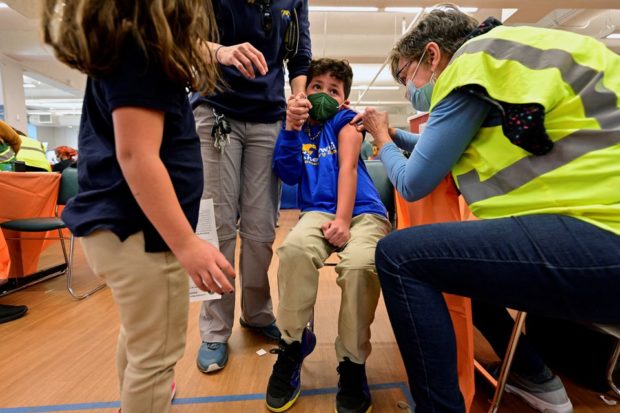
A child reacts while receiving a dose of the Pfizer-BioNTech coronavirus disease (COVID-19) vaccine at Smoketown Family Wellness Center in Louisville, Kentucky, U.S., November 8, 2021. REUTERS FILE PHOTO
A panel of advisers to the U.S. Food and Drug Administration on Wednesday unanimously voted to recommend Moderna Inc’s COVID-19 vaccine for children under 6 years old and Pfizer Inc and BioNTech SE’s for children under 5.
The following are some important details to know about these two messenger RNA (mRNA) vaccines for this age group.
How many doses are needed?
Moderna has asked the FDA to authorize a two-dose regimen of its vaccine in children aged 6 months to 6 years old. The 25-microgram doses are given 28 days apart. Adults received 100 micrograms per shot for their the first two doses.
Pfizer and BioNTech are asking for a three-dose course of their vaccine for children aged 6 months to under 5 years old. The first two doses are given 21 days apart and the third is administered at least two months after the second. Each dose is 3 micrograms, below the 10 micrograms given to children aged 5 to 11 and 30 micrograms for people aged 12 and older.
Both companies sought lower-dose versions for younger children to try to reduce vaccine side effects.
How effective are the vaccines?
The Moderna COVID-19 vaccine sits on the table at Trinity United Church of Christ in Chicago, Illinois, U.S., February 13, 2021. REUTERS/Kamil Krzaczynski
Moderna’s vaccine was estimated to be 50.6% effective at preventing symptomatic infections among children 6 months to under 2 years old and 36.8% effective at doing so in children ages 2 to 6 in a clinical trial of over 5,000 subjects.
It is not yet known how effective the Pfizer/BioNTech vaccine is at preventing infection in people under age 5 because of the low number of symptomatic COVID-19 cases among the children in its trial. An early analysis based on 10 symptomatic COVID-19 cases suggested a vaccine efficacy of 80.3% in this group. Once 21 children in the trial contract symptomatic COVID-19, the companies can finalize the vaccine’s efficacy.
Both the company’s trials showed that the vaccines generated a similar immune response to those seen in older age groups.
Are the vaccines safe for children?
Neither vaccine has raised any serious safety issues in the trials.
Heart inflammation known as myocarditis and pericarditis has been found to be a rare side effect of the vaccines in young men, but there have been few cases reported in the United States in children ages 5 to 11, and none in either of these trials for the youngest age group.
What are the side effects?
Some children reported pain and swelling at the injection site after vaccination from both vaccines.
Pfizer/BioNTech’s new pediatric COVID-19 vaccine vials are seen in this undated handout photo. Pfizer/Handout via REUTERS
Pfizer’s low-dose vaccine was generally better tolerated, with only sightly more participants who received the vaccine complaining of fevers, irritability or fatigue when compared with those who received a placebo. In ages 2 to 4, 33.7% of participants who received their second dose of the vaccine reported one of these side effects, compared to 32.2% who received placebo.
For Moderna’s vaccine, 58.9% of 3 to 5 year olds reported some type of reaction like fever, headache or fatigue after receiving their second dose, compared with 37.2% of participants who received placebo.
Why vaccinate young children?
COVID-19 is generally milder in children than adults, but there have been more than 440 U.S. COVID deaths among those under age 5, according to FDA officials.
Data has shown that in older children and adults, vaccines protect against hospitalization and death, according to Dr. Matthew Harris, a pediatric emergency medicine physician at Northwell Health in New York.
People who had a COVID-19 infection and received a booster shot had the most protection against COVID-19, he said.
RELATED STORIES
US FDA advisers overwhelmingly back Moderna COVID vaccine for ages 6-17
FDA amends EUA of Moderna’s anti-COVID jab to allow its use for kids age 6-11
Pfizer COVID-19 vaccines safe and effective for small children–US FDA staff
FDA to soon authorize Pfizer’s COVID booster shot for younger kids — NYT